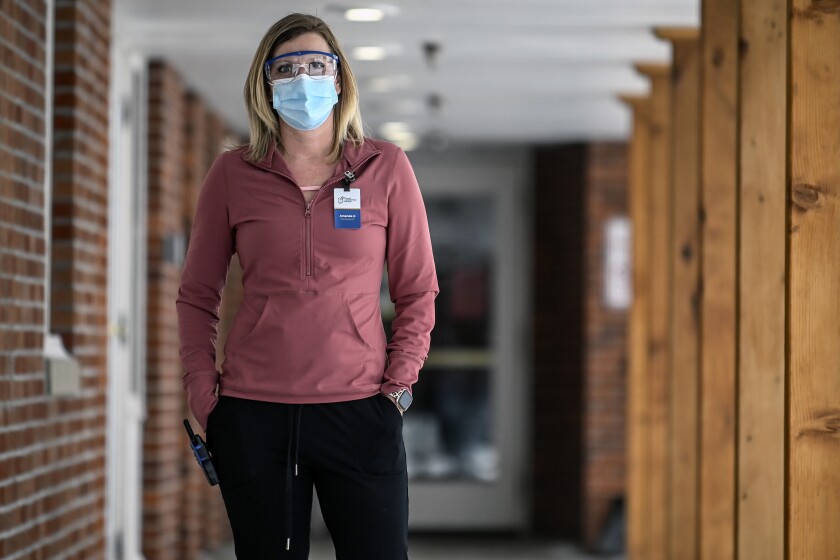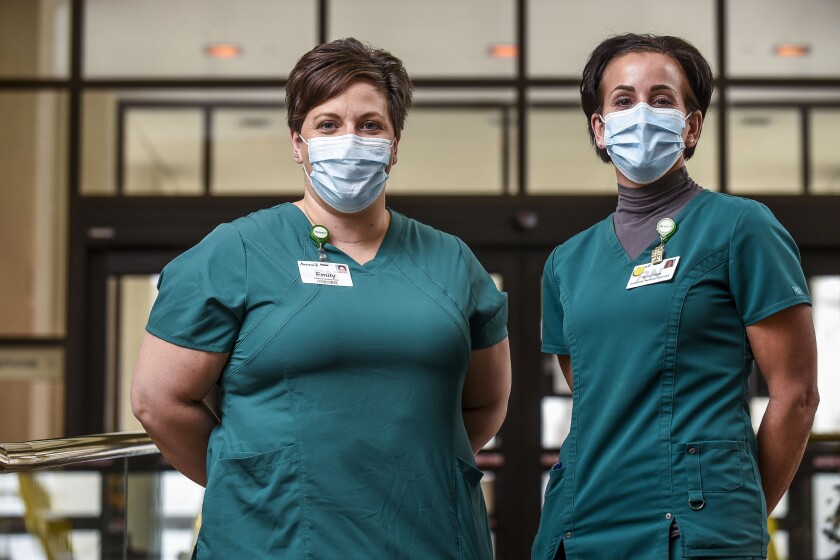Facing a deadly threat, health care workers defended and treated sick South Dakotans unlike ever before in 2020.
They were the people who treated the nearly 100,000 people who tested positive for COVID-19 and took care of more than 5,000 individuals who were hospitalized. Frontline health care workers were at the bedside of the 1,488 individuals who died as a result of the coronavirus, oftentimes alone.
It was a difficult year for everyone, but it was undoubtedly improved by the hard work and efforts of nurses, doctors, caretakers who wore protective gowns and gloves, masks and face shields and provided care and stood watch over our sickest neighbors and friends when needed most.
For that reason, the region’s health care workers are the Mitchell Republic’s persons of the year for 2020. Here are a few of their stories about working during a year unlike any other:
Working with under pressure
Health care workers strip away scrubs and layers of protective equipment before leaving, but the sights, sounds and emotions of the day are a constant companion.
ADVERTISEMENT
Attachment to long-term patients is nothing new for Avera Queen of Peace emergency room and intensive care unit workers. But the COVID-19 pandemic has often made them the lone human lifeline to patients, who are secluded and in pain.
Health care workers are not just tasked with physical treatment, but emotional care and they must do so without outward emotion. Face masks cover smiles and facial expressions that often offer comfort and laughter, adding to the tension already heightened with elongated shifts packed with stressful situations.
“Our average length of stay for patients was three to five days and our COVID patients are with us much longer than that,” said Kristi Riggs, AQOP director of Medical/Outpatient Treatment Center/ICU/Swing Bed. “Watching them decline is really difficult and that patient attachment has formed. It’s very difficult to watch that every day and be the only person that patient is able to interact with person to person. We are able to interact with those patient’s families with iPads, but it’s just not the same.”
The COVID-19 pandemic slowly made its way to South Dakota, but when it arrived at the end of the summer, it did not take long to engulf the state. In October and into November, South Dakota was one of the most COVID-afflicted areas in the world in cases and deaths and December was the state’s deadliest month, with 542 deaths.
In Mitchell, the emergency room and ICU began to fill and emotional exhaustion set in as the county was hit with 41 deaths in 43 days.
“I went into nursing to make a difference in people’s lives — to touch them on an emotional, mental and spiritual level — and a lot of what we do has nothing to do with medicine, it has to do with how we interact with patients,” said Emily Feldhaus, AQOP house supervisor. “… They can’t see our smile, you can’t see if they grimace when you touch them. As caregivers and humans, you need that physical connection. Eighty percent of communication is non-verbal and a lot of that is covered up.”
As hospitalizations and deaths began to pile up, it became increasingly more difficult for many health care workers to leave their emotions at the hospital. Frustrations were often increased upon seeing friends or acquaintances questioning the validity of COVID-19 on social media or seeing a community member in a store without a mask.
Fear of spreading illness and emotional exhaustion altered family dynamics for many health care workers, who are more accustomed to providing help rather than receiving it, even from family and friends.
ADVERTISEMENT
“As you go home, you want to touch and hug your family, but you feel you can’t do that because you’re scared you’re going to get them sick,” Feldhaus said. “A lot of times (nurses) rely on each other for support because nurses or caregivers as a group aren’t great at asking for help. We’re always the caregivers. Trying to accept help when offered or asking for help has been difficult because you feel like this is what we signed up for and we have to suffer through it.”
— Reported by Nick Sabato.

Carrying through a painful year
HOWARD — Amanda Stanghor sometimes has to borrow her own cell phone from a resident at the Good Samaritan Society in Howard.
The cell phone, and the cell phone of her many colleagues at the facility, which is part of the Sanford Health system, are often loaned to residents because the speaker phone feature is louder than the one found on normal cordless phones, making it easier for residents to hear and talk to their loved ones on the other end of the line.
It’s part of the numerous changes to the daily routine at assisted living centers around South Dakota that have had to adjust to life amidst the COVID-19 pandemic. Family visitation for the 39 current residents at the facility has been limited at times, putting a barrier between families that just want to share time with their loved ones.
“We do a lot more FaceTime, and it’s different seeing (residents) react to FaceTime. We’ve had multiple members on it and seeing their families lights up their faces,” said Stanghor, who serves as the registered nurse case manager and the interim director of nursing at the Howard location. “Previously, we would have families in big groups and have different celebrations. That all changed.”
ADVERTISEMENT
It’s all about keeping a population that is particularly vulnerable to COVID-19 safe while they receive the assistance they require in getting the most out of life in their later years. While Stanghor and other health care professionals were aware of the seriousness of the situation as it began to unfold, it took some time before the general population fully understood the gravity of the situation.
Soon, regular visits from the preschool and daycare schools stopped, replaced by the delivery of hand-drawn greetings and art projects. The Girl Scouts made personalized Christmas decorations. Other activities such as watching local high school sporting events -- which are often played right across the street from the home -- had to be curtailed.
Visitation was highly restricted when local COVID-19 cases were at a high, but some of those restrictions have been eased as local numbers come down.
“We have a room with a table set up with a plexiglas center, and it’s socially-distanced visitation. We ask the family to schedule visits but we try to be accommodating. Then we screen the family members and they wear a mask,” Stanghor said.
The facility had five residents die from COVID-19, and while long-term health care professionals are not strangers to the death of residents, it still has a strong impact knowing that health care workers are fighting the same disease around the world.
“It was very hard on the facility. We care for these people like they’re our family,” Stanghor said.
Residents and family members have been understanding about the restrictions, and the community itself has been supportive and helpful, Stanghor said. Their efforts helped keep COVID-19 out of the facility until October, when its first case emerged. But it did take some time for community members to understand the amount of impact community cases had on the how the home operates.
“The community has been amazing throughout. But I do think it took time for them to understand how much the community spread impacts us,” Stanghor said. “It puts us at higher risk of it getting into the facility.”
ADVERTISEMENT
Vaccinations began at the Howard home at the end of December, creating a sense of hope on the horizon, Stanghor said. It’s a hope that’s shared among the 800 skilled nursing facility residents and the 1,900 facility employees under the Sanford banner, as well as the state’s 270 nursing homes and assisted living centers.
“At the beginning it was all about keeping them safe, but I’m looking forward to focusing on their quality of life again and their happiness instead of just keeping them safe,” Stanghor said. “Which is obviously still very important, but I’m looking forward to them coming out that side as well.”
— Reported by Erik Kaufman

Busier than ever in Plankinton
PLANKINTON — It’s before 8 a.m. and Melissa Davis is planning to make room for an extra patient at the Aurora County Community Health Center.
That’s before her regular schedule of appointments begins, or before she makes a home visit and later stops at Aurora Plains Academy to check on children there. She’s worried about another patient, so she will see them over her lunch hour. The Plankinton clinic is supposed to close at 5 p.m., but she might not leave until 6 p.m., when she goes home and sees her husband, Cordell, and her three children, who will be preparing supper. If there’s an emergency, she might get called as a volunteer EMT for the Plankinton Ambulance.
All in a day’s work for Davis, a certified nurse practitioner and a primary provider in the small, rural community. She estimates that the Horizon Health Care location has seen about 300 patients a month toward the end of the year, a 50 percent increase over pre-pandemic counts. Davis said it’s stressful but she credits her fellow staff and family for helping get the work done and being supportive.
ADVERTISEMENT
“I really don’t like to tell anyone no,” she said. “If I can make it work, I will because I could see myself being in that position with my family, needing to know or feeling sick.”
The clinic is one of the few in the area with rapid testing capabilities, she said, with the ability to get results back within 15 minutes. That has drawn patients from as far away as 45 miles, and with the clinic doing what they can to fit everyone in.
The clinic has an X-ray room in which Davis and her staff can do almost any imaging they need -- which is important in deciphering symptoms of COVID-19 or pneumonia -- and it has a lab that is churning out both COVID-19 tests and blood and cell testing.
Since March, Aurora County has had more than 410 cases of COVID-19 -- the equivalent of 1 in 7 residents contracting the virus -- and eight deaths. There have been some preventative measures taken, most notably involving closing the city pool for the summer and closing the school to in-person learning for a week when an outbreak of cases occurred in October.
But life has chugged along and Davis understands why. She knows that South Dakota has ranked among the worst nationally for COVID-19 cases per capita but said she appreciates the state’s hands-off approach to stay-at-home orders or mandates.
“There are people that are being responsible and there is a good balance with what people are doing,” Davis said. “We still have to live, we still have to be a part of society. … I’m proud of our state. Everybody has to have a little freedom to do what they think is best.”
Because of how busy hospitals are, the Aurora County clinic is treating more cases where someone might need fluids or oxygen and the short, brick building on Main Street is playing a bigger defensive medical role than ever.
“Hospitals not taking patients, that is something that is completely new to us,” Davis said. “Our goals are to keep people out of ER and keep people at home.”
ADVERTISEMENT
Davis recently got her first dose of the COVID-19 vaccine, which she said was an exciting end to the year.
“We’re on our way out of this,” she said.
— Reported by Marcus Traxler









